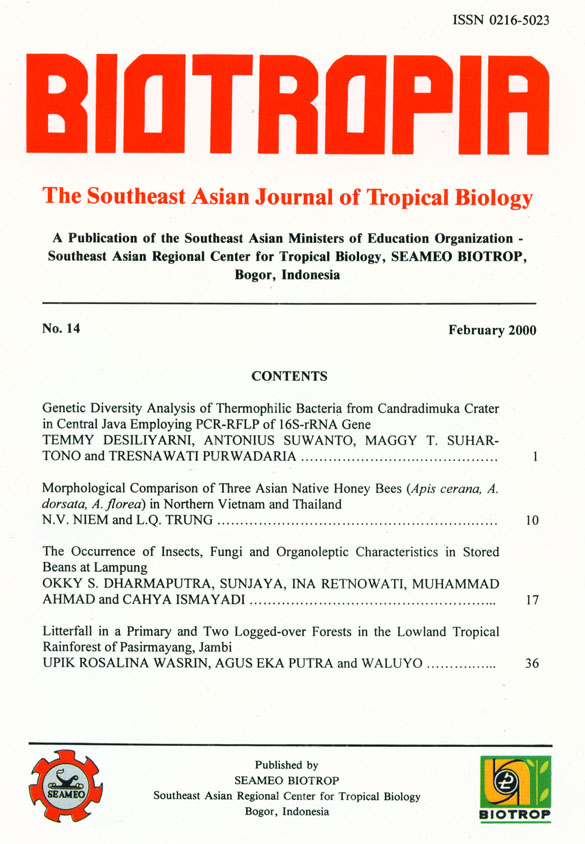
SEAMEO BIOTROP
Southeast Asian Ministers of Education Organization
707
views
Tags
GENETIC DIVERSITY ANALYSIS OF THERMOPHILIC BACTERIA FROM CANDRADIMUKA CRATER IN CENTRAL JAVA EMPLOYING PCR-RFLP OF 16S-rRNA GENE
24 May 2019 - 10:12 am (7 year ago)
Content Language : English
Content Language : English

Category :
Applied Science
The specific primers for bacteria (63f and 1387r) were used to amplify the 16S-rRNA genes from total
community genomic DNA of thermophilic bacteria. The total community genomic DNA was obtained
from muds and water samples of Candradimuka crater, Dieng Plateau, Central Java. PCR products were
cloned into vector pCR*2.1-TOPO (3.9 kb) and transformed into Escherichia coli TOPIC. Two tetrameric
restriction endonucleases Rsal and Hhal were employed to generate Restriction Fragment Length
Polymorphisms (RFLP) paterns. These enzymes yielded 10 and 9 groups of 16S-rRNA profiles or OTU
(Operational Taxonomic Units) from 27 16S-rRNA gene clones. Rsal was found to be more discriminative
in differentiating the clones than Hhal. Rsal-RFLP indicated that OTU 7 and OTU 3 represented the most
abundant clones, i.e. 6 and 5 clones respectively. The distribution of 16S-rRNA gene clones could indicate
relative distribution of specific groups of thermophilic bacteria in their natural habitat. Analysis of
diversity at the DNA level could represent both culturable and unculturable bacteria in the environment.
Similarity analysis showed that at level 0.600 there were 8 different groups from 10 RFLP profiles
generated by Rsal digestion. This study indicated that there were at least 8 groups of different
thermophilic bacteria occupying Candradimuka crater.
community genomic DNA of thermophilic bacteria. The total community genomic DNA was obtained
from muds and water samples of Candradimuka crater, Dieng Plateau, Central Java. PCR products were
cloned into vector pCR*2.1-TOPO (3.9 kb) and transformed into Escherichia coli TOPIC. Two tetrameric
restriction endonucleases Rsal and Hhal were employed to generate Restriction Fragment Length
Polymorphisms (RFLP) paterns. These enzymes yielded 10 and 9 groups of 16S-rRNA profiles or OTU
(Operational Taxonomic Units) from 27 16S-rRNA gene clones. Rsal was found to be more discriminative
in differentiating the clones than Hhal. Rsal-RFLP indicated that OTU 7 and OTU 3 represented the most
abundant clones, i.e. 6 and 5 clones respectively. The distribution of 16S-rRNA gene clones could indicate
relative distribution of specific groups of thermophilic bacteria in their natural habitat. Analysis of
diversity at the DNA level could represent both culturable and unculturable bacteria in the environment.
Similarity analysis showed that at level 0.600 there were 8 different groups from 10 RFLP profiles
generated by Rsal digestion. This study indicated that there were at least 8 groups of different
thermophilic bacteria occupying Candradimuka crater.
Link

This work is licensed under a Creative Commons Attribution-NonCommercial-NoDerivatives 4.0 International License.
